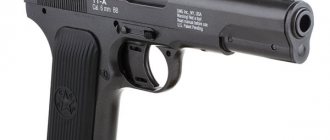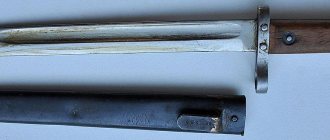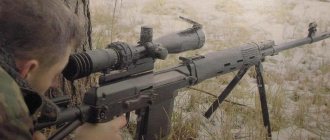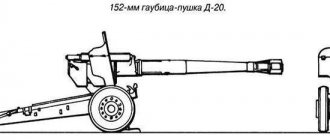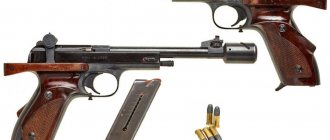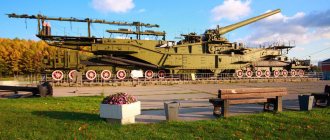The troops tested S.A. pistols. Cow of different models, pistol S.A. Prilutsky, and since 1929 F.V. also joined. Tokarev, who proposed a “pistol-carbine” with a 22-round magazine, a removable butt and a wooden fore-end. In 1930, a special commission headed by division commander V.F. Grushetsky conducted field tests of Soviet experimental and foreign production pistols. The weapon was tested for accuracy, combat rate of fire, speed and ease of reloading and, of course, reliability in conditions close to combat. In addition, endurance tests were carried out with the firing of 2000 rounds. A total of 17 models of pistols were tested, among which the best were the products of Tokarev and Prilutsky.
Diagram of operation of the automatic pistol Colt M1911
Repeated tests in the presence of the leadership of the Red Army revealed the winner. It was the Tokarev pistol, which was put into service under the designation “7.62 mm pistol of the 1930 model “Tula-Tokarev”. Abbreviated as TT. The experimental pistol was not quite suitable for mass production. Therefore, its refinement took time - the TT went into production only in 1933 with some minor changes caused by technological requirements.
Colt + Mauser = TT
Structurally, Fedor Vasilyevich Tokarev's pistol is very similar to the Colt M1911 pistol of 11.43 mm caliber (designer John Browning). Which, in fact, is not accidental. For Colt was the most popular pistol in the Russian army after the Mauser C96. For example, in 1916, 100 thousand Colt M1911 pistols and 5 million cartridges for them were ordered in the United States. By January 1917, 47 thousand pistols and about 2 million cartridges were sent to Russia.
In both the TT and the Colt M1911, the automatic action operates due to the recoil of the barrel during its short stroke. The barrel is unlocked and locked by lowering and raising the breech, which swings on a special earring (see diagram). The TT barrel has two annular lugs that engage with the inner surface of the bolt casing. The shutter-casing itself is equipped with internal grooves with which it slides along the frame guides. The return spring is installed under the barrel, and a guide rod is inserted into its rear end. The magazine is held in the handle frame by a push-button latch. This is where the similarities with Colt end, however.
TT pistol structure: 1 - frame, 5 - magazine latch, 7 - split pin, 10 - trigger spring, 12 - trigger, 13 - trigger block, 14 - barrel, 15 - earring, 16 - earring axis, 17 - housing-bolt , 18 — guide sleeve, 19 — return spring tip, 20 — return spring, 21 — guide rod, 22 — hammer, 23 — hammer spring, 26 — trigger, 27 — hammer axis, 28 — mainspring, 29 — sear, 31 - sear axis, 32 - disconnector, 33 - bolt stop, 34 - magazine
Tokarev designed the single-action trigger mechanism (trigger mechanism) with an eye on the Mauser C 96 - in the form of a block (pad), which was easy to remove when disassembling the pistol (which greatly simplified both the disassembly of the weapon and cleaning). The trigger was distinguished by an original feature - a mainspring located inside the open trigger. The characteristic drawback of the Colt was also taken into account, namely, delays when the upper part of the magazine was damaged. The presence of guides in the trigger block for feeding a cartridge made the pistol's power system less sensitive to dents or bends on the magazine body.
Unlike the “American”, the TT did not have special safeguards against an accidental shot. If the Colt could boast of two fuses - automatic (it turned off when the pistol was taken in the hand) and non-automatic, then the TT's trigger played the role of a fuse. It could be put on a “safety cock”, which, according to Tokarev, completely excluded an accidental shot during a fall or impact. Practice showed how much he was wrong. But more on that below.
For technological reasons (in order not to purchase new machines), the caliber for the TT-33 was “rifle”. At the same time, the 7.62x25 mm cartridge was created on the basis of the 7.63 mm cartridge for the most popular imported pistol in the USSR, Mauser C-96. Structurally, the Soviet cartridge differed from the German one mainly in the widened groove of the cartridge case for the ejector, which increased the reliability of the automation. The main advantage of the TT cartridge was the high muzzle velocity - 420 m/s - and, consequently, high penetration ability. From 10 meters, a bullet fired from a TT pierced a 3-mm steel sheet and penetrated 10 cm into a brick wall (“Nagan” and “Parabellum” could only boast 8 cm). And when shooting from 25 meters at a package of pine boards, 25.4 mm thick with a gap between the boards of 75 mm, the TT bullet penetrated 6-8 boards.
Soviet TT-33
However, the increased power had to be paid for with a sharp and strong recoil, a powerful muzzle flash, and also a low stopping effect. In practice, this meant that the enemy, even mortally wounded by one or two bullets fired from a TT, could still return fire. With the prototype, the Colt M1911, with its heavy, large-caliber, low-velocity bullet, this was practically impossible.
Externally, the TT looked like a budget version of the Colt - almost no protruding parts, except for the slide stop, and a simple-shaped handle with ebonite pads in the style of the Browning pistol of the 1903 model. However, such simplicity also had its advantages. The pistol, for such a powerful cartridge, turned out to be quite light, compact, and most importantly, narrow (which makes it easy to hide it, for example, in a sleeve or belt). Its length is 195 mm, barrel length - 116 mm, height - 120 mm, width - 28 mm. Weight without cartridges - 825 g, with cartridges - 910 g.
If we evaluate the main advantages of TT, then they are as follows. Firstly, and not least thanks to the cartridge, the TT is quite accurate. At a distance of 50 m, the dispersion radius for the new pistol is 15-16 cm. At 25 meters, it is not difficult to place all fired bullets in a circle with a radius of 7.5 cm. Secondly, with the TT, even a beginner feels like a sniper. The trigger is designed so that the trigger force is low, the trigger itself is short, the handle fits well in the hand, and the pistol has good balance. Another advantage over the same Makarov pistol is the long barrel and, accordingly, a long sighting line. Thirdly, the TT is simple and easy to disassemble without tools. Unfortunately, during its use among the troops, it turned out that the pistol’s shortcomings almost outweighed its advantages.
Advantages and disadvantages of the model
The TT pistol has its advantages over its previous types and contemporary models, as well as some disadvantages, among them:
Fairly simple manufacturing process
Simple and reliable to use
Light weight - comfortable to wear
Maximum penetration performance - can easily penetrate a steel helmet from 50 m, and the dispersion radius is 15 cm.
Excellent accuracy and easy trigger
Durable metal body and parts
TT only for close combat
The magazine latch is not reliable enough - the magazine with ammunition could fall out of the handle
Small clip for 8 rounds
The safety design is not ideal - during a fall, a loaded weapon can fire
The swinging earring wears out and stagnation is possible when shooting
The handle is located at right angles to the barrel - when thrown, the barrel will be slightly lower than the target (practice required)
Best the enemy of the good
The pre-war TT pistol was highly reliable, but at the same time, alas, had a short service life. After shooting about 1000 rounds, trouble begins. The most famous is a spontaneous shot during a fall. It just so happened that Fedor Tokarev’s “harmful” product often fell on the trigger. Due to wear on the trigger parts, the safety cock did not hold the trigger and a shot occurred. The number of accidents, as the troops and the NKVD became saturated with new pistols, increased to such a critical level that it came down to special instructions prohibiting the carrying of a TT with a cartridge in the chamber. And the reference books for investigators included typical cases of “self-inflicted gunshots” from TT.
The most interesting thing is that constantly wearing the TT with the hammer in the safety half-cock position led to excessive tension on the mainspring and, as a result, to its rapid wear. Which was fraught with misfire at the most crucial moment. Wear on the magazine latch caused it to spontaneously fall out. In addition, the locking mechanism earring wore out and the return spring quickly “tired.” As a result, delays began in the form of the cartridge sticking and its distortion when the automation was operating. The “last straw” was the complaints received from tankers that it was impossible to shoot from the TT through the loopholes in the turrets of tanks and armored vehicles. As a result, already in 1939, i.e. 6 years after the TT-33 was put into service, a new competition was announced.
TT-33 - personal weapon of Soviet officers
The commission examined several experimental models of I.I. pistols. Rakova, S.A. Korovina, P.V. Voevodina and F.V. Tokarev. All of them were distinguished by an open barrel (a requirement of armored forces), a magazine for 8-9 rounds, the presence of a non-automatic safety and (some) a lower magazine latch, which absolutely prevented its loss. Tokarev, among other things, prepared a compromise project for the modernization of the TT-33. The new-old pistol, in addition to slightly improved automatics, had a 12-round magazine with a bottom latch. However, the competition was won by the Vojvodina pistol, which was planned to be put into production in 1941. Alas, the unsuccessful start of the war and the subsequent mass evacuation of enterprises to the east confused all plans.
The device of the Tula Tokarev pistol
While working on the TT model, Tokarev attracted the most successful developments of his predecessors, combining several already existing systems:
- design from Browning M1903;
- bore locking mechanism from Colt M1911;
- cartridges from Mauser C96.
The engineer also introduced his own developments - he placed the trigger device in a separate block. Now it could be removed from the frame for cleaning and lubricating the weapon. Tokarev placed a mainspring in the trigger, and to make using the weapon more convenient, he made some other modifications.
The automation is designed according to the principle of a short stroke of the pistol barrel. Ammunition is fed automatically into the chamber, and the barrel bore is also automatically opened and closed, with the ejection of the spent cartridge case.
Military career
The defeat of the summer of 1941 led to the fact that the Red Army simply began to run out of weapons. In addition, evacuations, shortages of skilled workers and increased plans to replace huge losses in weapons led to a sharp drop in quality. If the pre-war TT began to “glitch” after 1000 shots, then military-issue pistols could withstand at most 700-800 shots without breakdowns or delays. Particularly unsuccessful were the pistols produced in 1942, which were distinguished by emphatically rough metal processing and simplified wooden grips instead of ebonite ones. However, wooden overlays were often found on TTs produced in 1943-45.
The situation was also aggravated by the use of armor-piercing cartridges from submachine guns. This led to rapid wear of the TT, which was already not “suffering” from a long service life. At the same time, there were cases of breakage of the firing pin stoppers, after which the latter flew into the shooter’s face, and other malfunctions (for example, swelling of the chamber, after which the cartridge case could only be removed with the help of a rod and a hammer). However, this was not so scary, since the main weapon of officers since 1942 has become a machine gun, and the pistol gradually turned into a “last chance” weapon.
Interestingly, captured pre-war TTs were used in the Finnish and even German armies. In the Wehrmacht, the TT under the designation Pistole 615 (r) was issued to rear and security units, police (in occupied territories), as well as volunteers (for example, Kuban Cossacks) who fought on the side of the Third Reich.
Obtaining a weapons permit
Citizens of Russia are prohibited from owning military short-barreled weapons. But you can use traumatic (only for self-defense), having previously obtained a license and permission. To do this you need:
- undergo a medical examination;
- take courses on mastering this weapon;
- pay the state fee, have two 3x4 photos;
- prepare a place in the house for storing a pistol;
- come with a statement to the police station.
You should keep an eye on the license expiration date, as there is a fine for an expired license.
From "Gyurza" to "Boa"
The appearance of the “Boa Constrictor” was preceded by the creation of other powerful weapons. By the early 1990s, the need became obvious to develop a new pistol cartridge for the armed forces and law enforcement agencies, which could penetrate widespread light body armor (level Br1 according to GOST R 50744-95 or level 2a-3a according to the classification of the American National Institute of Justice (National Institute of Justice) with minimal loss of lethality.
For this purpose, a pistol cartridge of increased efficiency 9x21 mm was developed. By 1995, the TsNIITochmash team under the leadership of Pyotr Serdyukov designed the SR.1 (Special Development - 1), which also received the designations SPS (Serdyukov Self-loading Pistol) and “Gyurza” (export-oriented model). Currently, potential customers are offered two versions of the pistol - the modernized SR.1M and equipped with Picatinny rails (MIL-STD-1913) SR.1MP, which allows the installation of a silent firing device (SDS) and a number of shooting accessories, including laser target designators (LTD) , tactical flashlights and red dot sights.
At the same time, the basic modification - SR.1M - is not equipped with a muzzle thread for attaching a muffler and a Picatinny-type unit. It has a place for installing a PBS and a bracket with four small-sized rails for shooting accessories.
SR.1M uses two types of 9x21 mm cartridges:
- SP-10 with an armor-piercing bullet,
- SP-11 with a full metal jacket bullet.
The automatic operation of the pistol is based on the use of recoil energy with a short barrel; the barrel is locked by a swinging lock. The weapon is equipped with a reliable system of automatic safety locks, one of which is located on the back of the handle (sear lock), and the second on the trigger. The use of such a scheme makes it possible to ensure the safety of working with the SR.1M, and on the other hand, to significantly reduce the opening time of fire, since when removing the weapon from the holster, the fuses are instantly turned off by the palm and index finger, respectively.
Along with the streamlined shape of the parts, they significantly increase the convenience of concealed carry (Concealed Carry) of the pistol. SR.1/SR.1M became the first domestic serial pistol to receive a pistol frame made of high-strength polymers.
Publication from JSC TsNIITOCHMASH (@cniitm) November 29, 2022 at 12:30 PST
A distinctive feature of the SR.1M is its power, which allows it to penetrate all types of light military body armor. The power of the SP-10/SP-11 pistol cartridge is so great that when editing GOST R 50744-95, which regulates the development of personal protective equipment, a special class of protection against these ammunition was introduced - Br2. Serdyukov later recalled that in the late 1990s, the firepower of the SR.1 shocked American military personnel.
“In 1997, we were at an American base where a new body armor and helmet for the US Army were being demonstrated. The delegation from TsNIITochmash brought with them our development - the SR.1 pistol. The Americans jokingly suggested testing it on their newest body armor. “The Gyurza pierced right through both the bulletproof vest and the armored helmet the first time,” noted the designer.
Thus, SR.1/SR.1M can be considered the most powerful combat pistol in the world. At the time the development of “Udava” began, TsNIITochmash had very significant experience in the design and production of high-power pistols.
By the way, in 2014, the authors of this material had the opportunity to familiarize themselves with the penetrating ability and damaging effect of SR.1M pistols chambered for 9x21 mm, and based on the results of firing at the institute’s training ground, they stated the extremely high combat effectiveness of this weapon.
Available analogues
The best variation of the TT pistol is considered to be the M57 model. This modification was developed according to Tokarev’s drawings by the Yugoslav company Zastrava Arms. This pistol is produced today and supplied to a number of European countries. The weapon has a number of design features that distinguish it from the prototype. In particular, the designers lengthened the handle, increasing the magazine capacity. The pistol now has a safety lever that “locks” the bolt casing and the trigger mechanism. In general, Yugoslav gunsmiths have significantly redesigned the ergonomics of the pistol and increased safety in handling.
Pistol Zastava M57
The Hungarians made a good modification. They created the T-58 model with an interchangeable barrel, adapted for firing cartridges of 9 and 7.62 mm caliber. The fuse for this pistol is a flag type, located on the left side of the box.
Description
TT from the ATO zone, you don’t come across it often!
Hurry up to buy. Caliber 7.62 × 25 mm TT Muffler +7000 RUR Thread for muffler 13*1 right (most common) Live cartridges 7.62 × 25 mm TT 50pcs 1500 RUR To order, write to email or telegram: t.me/complex_gun Shooting:
/wp-content/uploads/2020/01/complexxxxtt.mp4
